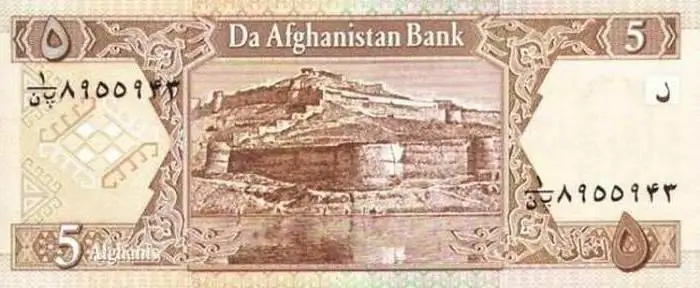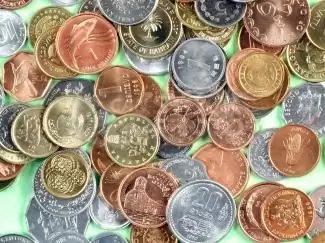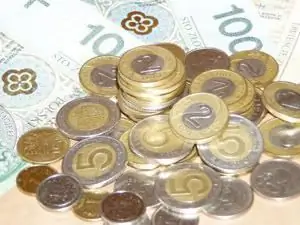2026 Author: Howard Calhoun | [email protected]. Last modified: 2025-06-01 07:12:56
The official Polish currency (monetary unit) is called złoty. It is equivalent to 100 grosz. Banknotes with denominations of 10, 20, 50, 100 and 200 zlotys are in circulation in the country. Coins with denominations of 1, 2 and 5 złoty are widespread. There are also coins of 1, 2, 5, 10, 20 and 50 groszy. Residents of the country, especially students, due to the low cost of goods, often use coins for daily purchases.
What is the złoty?

Polish currency since 1995 has been officially called "Polish New Zloty". In foreign exchange markets and at exchange offices, it is common to use the abbreviation PLN. It was in 1995 that the last financial reform in the country was carried out. Both bills and coins of a new type came into use. In accordance with the new legislation, it was decided to carry out exchange transactions at the following rate: 10 thousand old zlotys are equal to 1 new zloty.
After 20 years, many residents of the state still use prices in the old format in conversations. So, 10 million zlotys is only 1 thousand. The exchange of American dollars and euros for zlotys is carried out not only in banks and exchange offices, but also in hotels, bus stations,airports and railway stations.
Interesting but true
Poland has been a member of the European Union for almost 20 years, but this fact does not affect the popularity of the national currency. The country is in no hurry to switch to the euro. The Polish currency belongs to the category of easily convertible monetary units, and it can be freely exchanged for another in almost all countries of the world. Tourists are advised to change euros or dollars not in banks, following European practice, but in special exchange offices. The exchange rate of the Polish currency is more attractive there. You can withdraw funds from Visa or Maestro cards at almost any ATM, but sometimes it is much more profitable to pay with cards. When paying for a product or service, the conversion will be made at the exchange rate of the country of the tourist.

The name of the Polish currency originated in the XIV-XV centuries. Then all gold foreign ducats were called zlotys. The first zloty was equal to 60 grosz and was called "polkop".
Features
Polish currency was created taking into account the needs of visually impaired people. To this end, each banknote has raised symbols that change depending on the denomination. For 20 zlotys there is a circle, for 50 - a rhombus, for 100 - a “+” sign, for 200 - a triangle. The government of the country has repeatedly changed the format of money. If in the XIV-XV centuries the dinars, which at that time replaced the national currency, looked like thick coins, then after a few centuries, the coins became so thin that they even had the property of breaking. ATIn 1924, a new monetary system was approved. For the first time, the zloty was divided into 100 groszy. The cost of the country's currency was estimated at 0.1687 grams of gold.
Polish exchange rate today

Today, the zloty is almost the most stable domestic European currency. The Polish zloty, despite the onslaught of the dollar in 2008, successfully survived the crisis.
As of March 17, 2015, the exchange rate of the national currency of Poland was:
- 1 euro - 4, 020 PLN.
- 1 dollar - 3, 775 PLN.
- 1 PLN - 13, 1603 rubles.
Currency pairs in the financial market, in which the zloty is present, are not very common among small speculators and large players. The low volatility and relative uncertainty of the monetary unit are the factors that determined the place of the Polish currency on the world market. The plans of the state included the transition to the euro in 2012, but the situation in the world has changed all priorities. Only after the state fulfilled the requirements of the ECB, the zloty became a full member of the EU financial system. Several factors affect the exchange rate at the same time: the general state of affairs in the EU and Poland's sovereign rating.
Recommended:
Zloty. Currency in Poland

Issues of money exchange always disturb visitors. What does the local currency look like? Which course is the most profitable? How not to get a fake?
The national currency of Turkey: what every tourist should know

The national currency of one of the most popular tourist destinations is the Turkish lira. This Turkish currency is mainly used only by local residents. Foreign guests prefer to pay in dollars, less often in euros or rubles. At the same time, they do not even realize that it is sometimes cheaper to pay for purchases in local currency
China's currency: what tourists need to know

The article describes the currency of China and the patterns of yuan turnover, as well as some features of the exchange of monetary units in Hong Kong
The currency of Afghanistan: the history of the currency. Curious information about the currency

Afghan currency Afghani has almost a century of history, which will be discussed in this material
What is a currency? Russian currency. Dollar currency

What is the state currency? What does currency turnover mean? What needs to be done to make the Russian currency freely convertible? What currencies are classified as world currencies? Why do I need a currency converter and where can I find it? We answer these and other questions in the article

